Qantas Airlines Report: Strategies, Analysis, and Recommendations
VerifiedAdded on 2021/05/31
|17
|3536
|220
Report
AI Summary
This report provides a comprehensive analysis of Qantas Airlines, a major player in the Australian and global airline industry. It begins with an executive summary and introduction, followed by a detailed examination of the macro and micro environments using PESTLE and Porter's Five Forces models. The report then delves into Qantas's competitive advantages, including its dual-brand strategy with Jetstar, strong domestic position, and reputation for operational excellence. The core of the report explores the generic and growth strategies employed by Qantas, with a focus on cost leadership (Jetstar) and differentiation (Qantas). The analysis covers market penetration and expansion strategies. The report concludes with strategic recommendations for Qantas's long-term welfare, reinforcing the importance of safety and customer service. The report is structured to provide a clear understanding of Qantas's position in the airline industry, its strategic choices, and its potential for future growth.
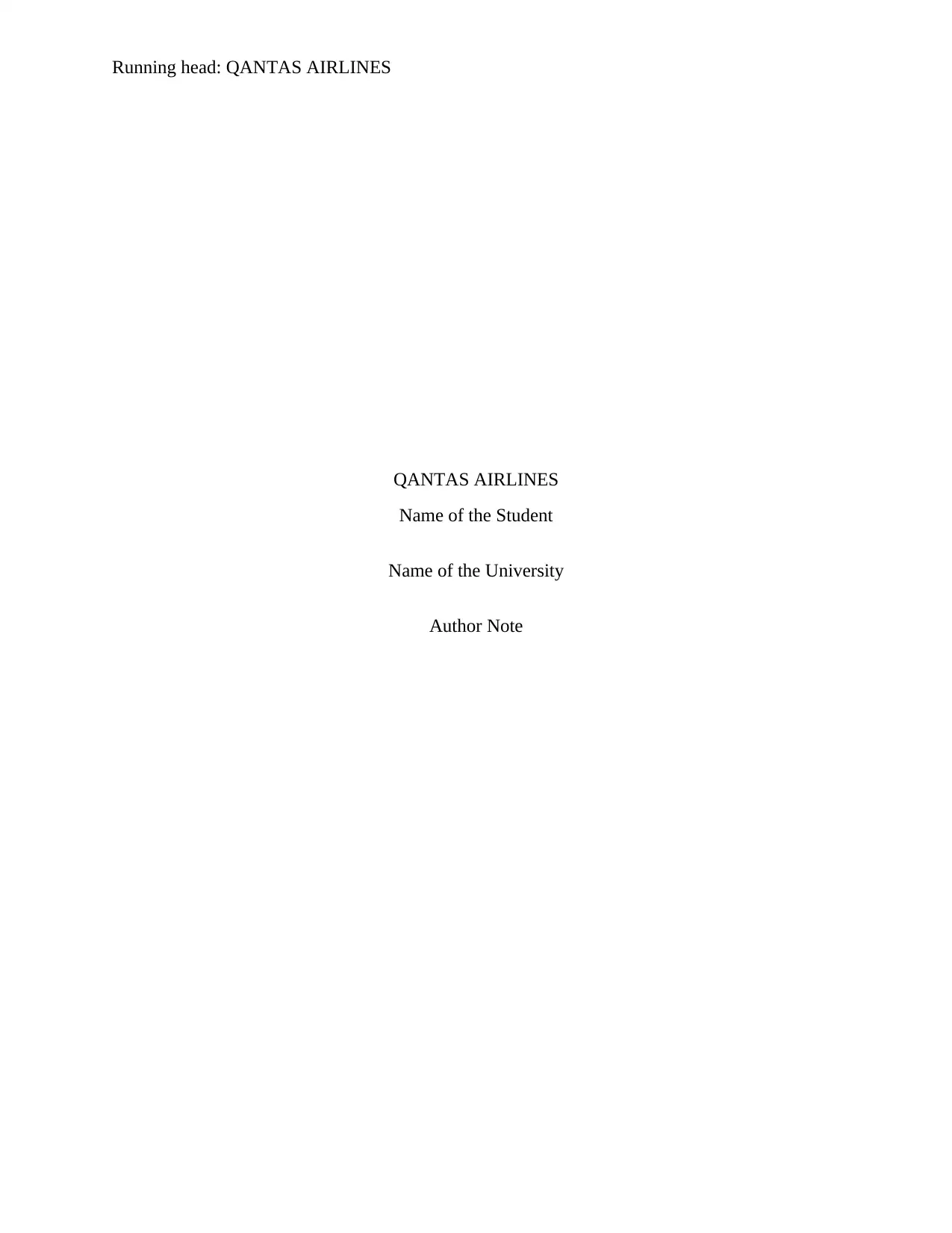
Running head: QANTAS AIRLINES
QANTAS AIRLINES
Name of the Student
Name of the University
Author Note
QANTAS AIRLINES
Name of the Student
Name of the University
Author Note
Paraphrase This Document
Need a fresh take? Get an instant paraphrase of this document with our AI Paraphraser
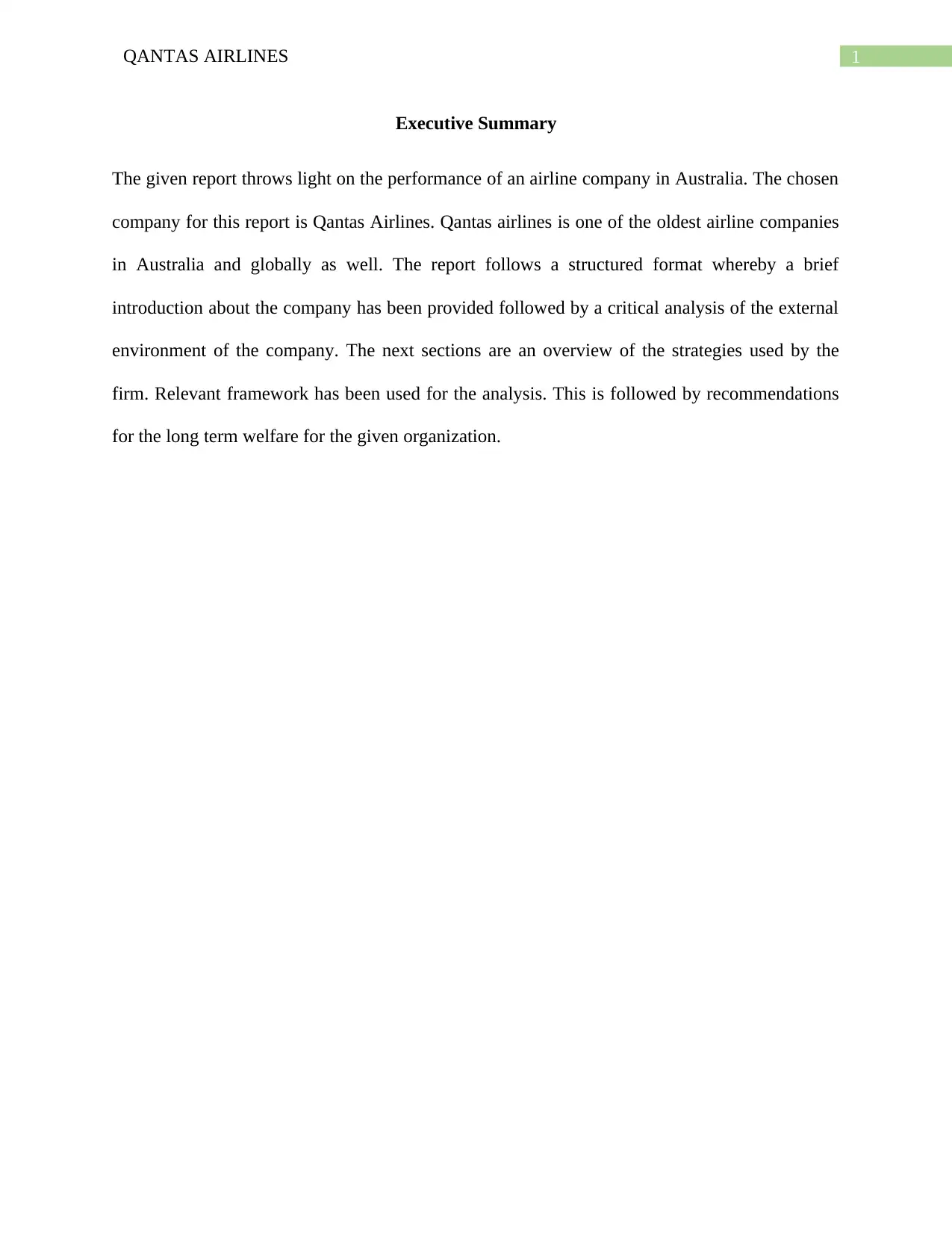
1QANTAS AIRLINES
Executive Summary
The given report throws light on the performance of an airline company in Australia. The chosen
company for this report is Qantas Airlines. Qantas airlines is one of the oldest airline companies
in Australia and globally as well. The report follows a structured format whereby a brief
introduction about the company has been provided followed by a critical analysis of the external
environment of the company. The next sections are an overview of the strategies used by the
firm. Relevant framework has been used for the analysis. This is followed by recommendations
for the long term welfare for the given organization.
Executive Summary
The given report throws light on the performance of an airline company in Australia. The chosen
company for this report is Qantas Airlines. Qantas airlines is one of the oldest airline companies
in Australia and globally as well. The report follows a structured format whereby a brief
introduction about the company has been provided followed by a critical analysis of the external
environment of the company. The next sections are an overview of the strategies used by the
firm. Relevant framework has been used for the analysis. This is followed by recommendations
for the long term welfare for the given organization.
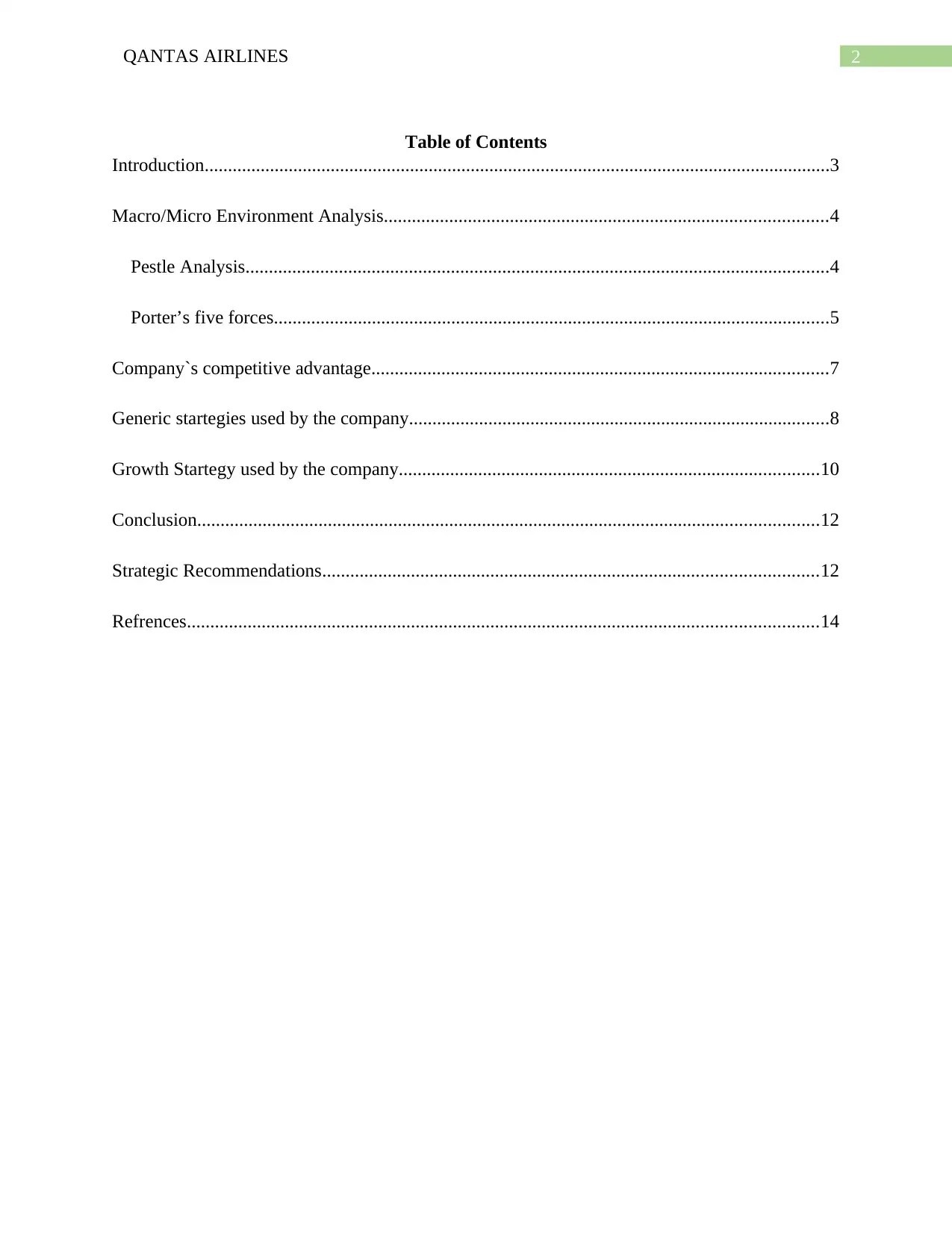
2QANTAS AIRLINES
Table of Contents
Introduction......................................................................................................................................3
Macro/Micro Environment Analysis...............................................................................................4
Pestle Analysis.............................................................................................................................4
Porter’s five forces.......................................................................................................................5
Company`s competitive advantage..................................................................................................7
Generic startegies used by the company..........................................................................................8
Growth Startegy used by the company..........................................................................................10
Conclusion.....................................................................................................................................12
Strategic Recommendations..........................................................................................................12
Refrences.......................................................................................................................................14
Table of Contents
Introduction......................................................................................................................................3
Macro/Micro Environment Analysis...............................................................................................4
Pestle Analysis.............................................................................................................................4
Porter’s five forces.......................................................................................................................5
Company`s competitive advantage..................................................................................................7
Generic startegies used by the company..........................................................................................8
Growth Startegy used by the company..........................................................................................10
Conclusion.....................................................................................................................................12
Strategic Recommendations..........................................................................................................12
Refrences.......................................................................................................................................14
⊘ This is a preview!⊘
Do you want full access?
Subscribe today to unlock all pages.

Trusted by 1+ million students worldwide

3QANTAS AIRLINES
Introduction
The airline industry of Australia has been doing considerably well as the given country
has achieved an excellent growth rate. The number of airlines operating in the given industry has
been growing considerably within the country as well as internationally. There are 49
international airlines which provide travel services in Australia. There are about 16 million
visitors who visit Australia annually (Abushova, Burova and Suloeva 2016). There are various
airports in Australia like Kingsford Smith International Airport in Sydney, Darwin International
airport, Townsville International Airport and others. The primary airlines operating in the given
country are Qantas, West Australian Airways, and Australian air express, Virgin Blue,
Maroomba Airlines and Airink. For the investigation of safety and other regulations, the
Australian Transport Safety Bureau (ATSB) is responsible.
The Qantas airways is the primary airline company of Australia and is one of the largest
airline companies with respect to the number and size of international flights. The airline is the
third oldest airline in the globe after Avianca and KLM. The original name of the airline
company is "Queensland and Northern Territory Aerial Services". The given airline is based in
Sydney and has a market share of around 65% in the domestic market and 15% internationally
(Qantas.com. 2018).
The given airline company has a brand called Jetstar Airways under its name which is a
low cost airline operating in international as well as domestic services (Alkhafaji and Nelson
2013). The given report will be discussing the different strategies which have been used by the
firm in order to establish itself in the international domain (Barney 2014). Certain
recommendations for the same will also be provided.
Introduction
The airline industry of Australia has been doing considerably well as the given country
has achieved an excellent growth rate. The number of airlines operating in the given industry has
been growing considerably within the country as well as internationally. There are 49
international airlines which provide travel services in Australia. There are about 16 million
visitors who visit Australia annually (Abushova, Burova and Suloeva 2016). There are various
airports in Australia like Kingsford Smith International Airport in Sydney, Darwin International
airport, Townsville International Airport and others. The primary airlines operating in the given
country are Qantas, West Australian Airways, and Australian air express, Virgin Blue,
Maroomba Airlines and Airink. For the investigation of safety and other regulations, the
Australian Transport Safety Bureau (ATSB) is responsible.
The Qantas airways is the primary airline company of Australia and is one of the largest
airline companies with respect to the number and size of international flights. The airline is the
third oldest airline in the globe after Avianca and KLM. The original name of the airline
company is "Queensland and Northern Territory Aerial Services". The given airline is based in
Sydney and has a market share of around 65% in the domestic market and 15% internationally
(Qantas.com. 2018).
The given airline company has a brand called Jetstar Airways under its name which is a
low cost airline operating in international as well as domestic services (Alkhafaji and Nelson
2013). The given report will be discussing the different strategies which have been used by the
firm in order to establish itself in the international domain (Barney 2014). Certain
recommendations for the same will also be provided.
Paraphrase This Document
Need a fresh take? Get an instant paraphrase of this document with our AI Paraphraser
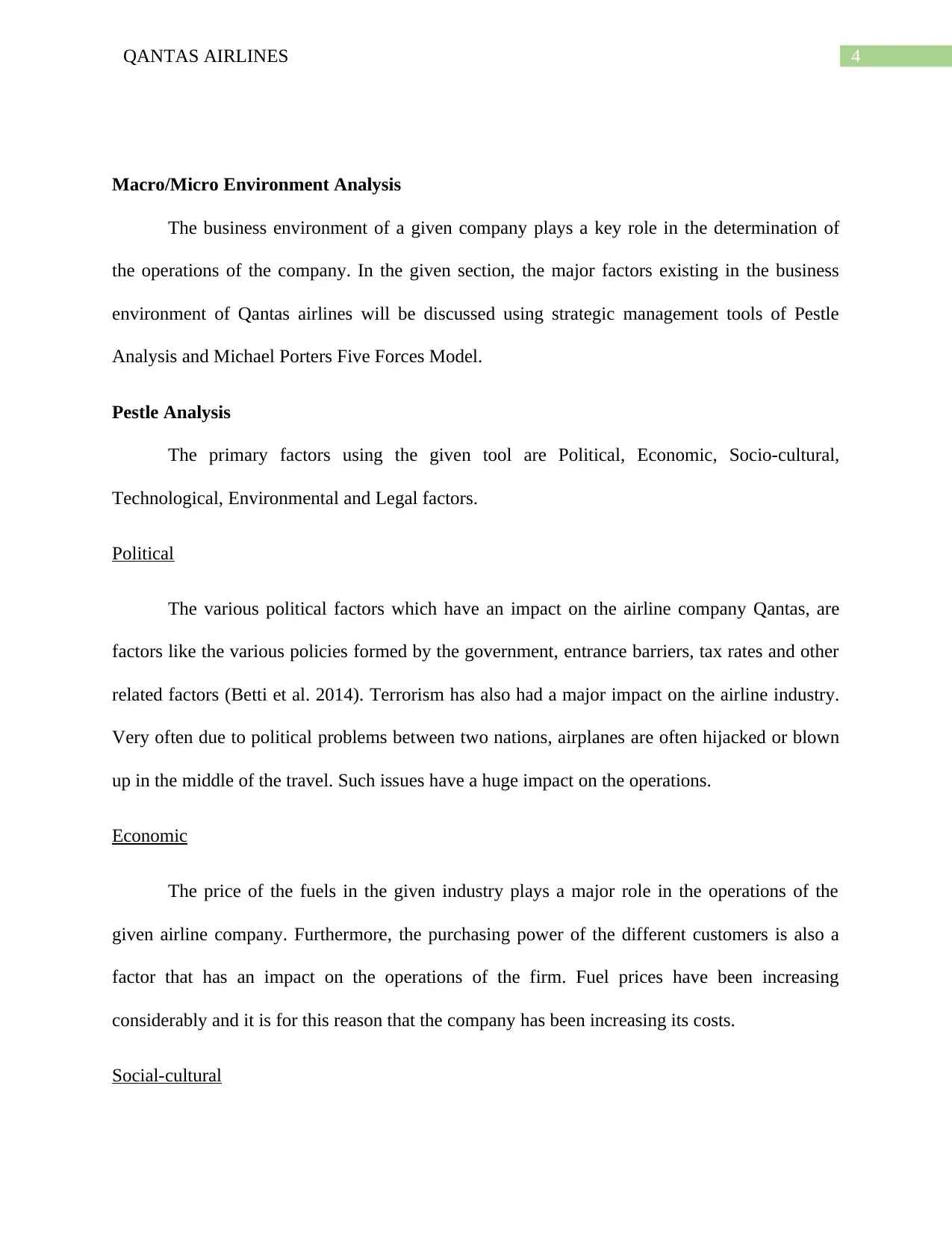
4QANTAS AIRLINES
Macro/Micro Environment Analysis
The business environment of a given company plays a key role in the determination of
the operations of the company. In the given section, the major factors existing in the business
environment of Qantas airlines will be discussed using strategic management tools of Pestle
Analysis and Michael Porters Five Forces Model.
Pestle Analysis
The primary factors using the given tool are Political, Economic, Socio-cultural,
Technological, Environmental and Legal factors.
Political
The various political factors which have an impact on the airline company Qantas, are
factors like the various policies formed by the government, entrance barriers, tax rates and other
related factors (Betti et al. 2014). Terrorism has also had a major impact on the airline industry.
Very often due to political problems between two nations, airplanes are often hijacked or blown
up in the middle of the travel. Such issues have a huge impact on the operations.
Economic
The price of the fuels in the given industry plays a major role in the operations of the
given airline company. Furthermore, the purchasing power of the different customers is also a
factor that has an impact on the operations of the firm. Fuel prices have been increasing
considerably and it is for this reason that the company has been increasing its costs.
Social-cultural
Macro/Micro Environment Analysis
The business environment of a given company plays a key role in the determination of
the operations of the company. In the given section, the major factors existing in the business
environment of Qantas airlines will be discussed using strategic management tools of Pestle
Analysis and Michael Porters Five Forces Model.
Pestle Analysis
The primary factors using the given tool are Political, Economic, Socio-cultural,
Technological, Environmental and Legal factors.
Political
The various political factors which have an impact on the airline company Qantas, are
factors like the various policies formed by the government, entrance barriers, tax rates and other
related factors (Betti et al. 2014). Terrorism has also had a major impact on the airline industry.
Very often due to political problems between two nations, airplanes are often hijacked or blown
up in the middle of the travel. Such issues have a huge impact on the operations.
Economic
The price of the fuels in the given industry plays a major role in the operations of the
given airline company. Furthermore, the purchasing power of the different customers is also a
factor that has an impact on the operations of the firm. Fuel prices have been increasing
considerably and it is for this reason that the company has been increasing its costs.
Social-cultural
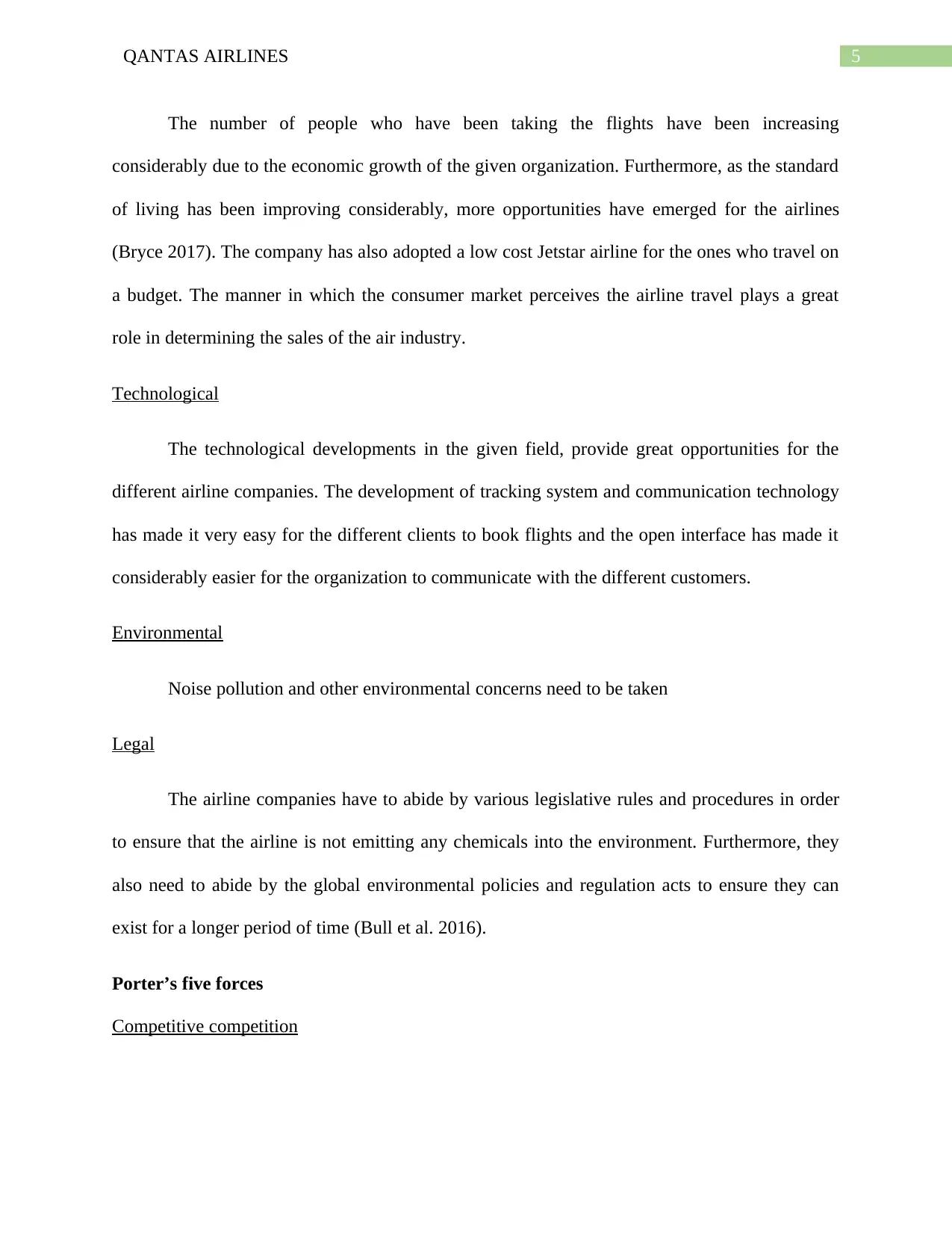
5QANTAS AIRLINES
The number of people who have been taking the flights have been increasing
considerably due to the economic growth of the given organization. Furthermore, as the standard
of living has been improving considerably, more opportunities have emerged for the airlines
(Bryce 2017). The company has also adopted a low cost Jetstar airline for the ones who travel on
a budget. The manner in which the consumer market perceives the airline travel plays a great
role in determining the sales of the air industry.
Technological
The technological developments in the given field, provide great opportunities for the
different airline companies. The development of tracking system and communication technology
has made it very easy for the different clients to book flights and the open interface has made it
considerably easier for the organization to communicate with the different customers.
Environmental
Noise pollution and other environmental concerns need to be taken
Legal
The airline companies have to abide by various legislative rules and procedures in order
to ensure that the airline is not emitting any chemicals into the environment. Furthermore, they
also need to abide by the global environmental policies and regulation acts to ensure they can
exist for a longer period of time (Bull et al. 2016).
Porter’s five forces
Competitive competition
The number of people who have been taking the flights have been increasing
considerably due to the economic growth of the given organization. Furthermore, as the standard
of living has been improving considerably, more opportunities have emerged for the airlines
(Bryce 2017). The company has also adopted a low cost Jetstar airline for the ones who travel on
a budget. The manner in which the consumer market perceives the airline travel plays a great
role in determining the sales of the air industry.
Technological
The technological developments in the given field, provide great opportunities for the
different airline companies. The development of tracking system and communication technology
has made it very easy for the different clients to book flights and the open interface has made it
considerably easier for the organization to communicate with the different customers.
Environmental
Noise pollution and other environmental concerns need to be taken
Legal
The airline companies have to abide by various legislative rules and procedures in order
to ensure that the airline is not emitting any chemicals into the environment. Furthermore, they
also need to abide by the global environmental policies and regulation acts to ensure they can
exist for a longer period of time (Bull et al. 2016).
Porter’s five forces
Competitive competition
⊘ This is a preview!⊘
Do you want full access?
Subscribe today to unlock all pages.

Trusted by 1+ million students worldwide
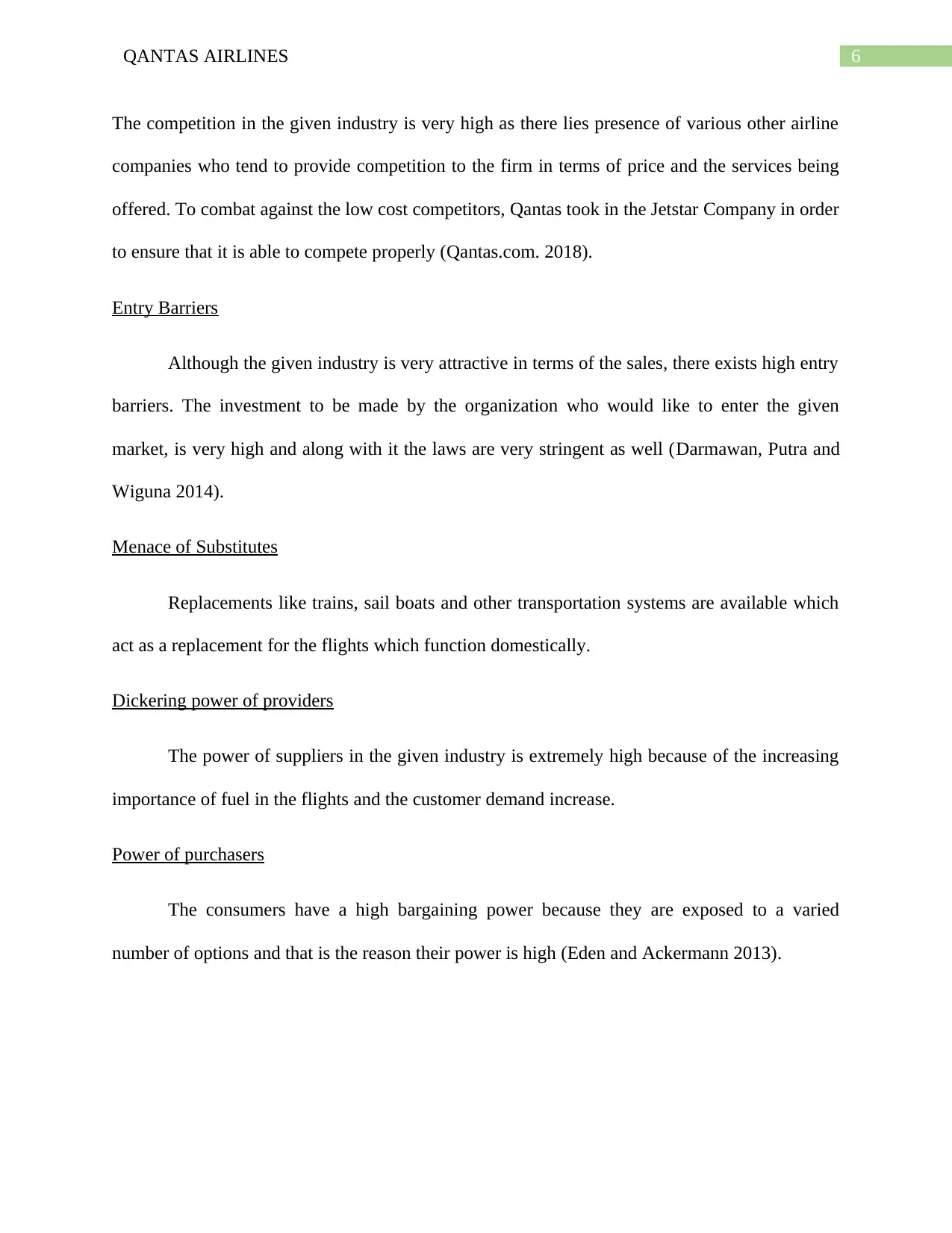
6QANTAS AIRLINES
The competition in the given industry is very high as there lies presence of various other airline
companies who tend to provide competition to the firm in terms of price and the services being
offered. To combat against the low cost competitors, Qantas took in the Jetstar Company in order
to ensure that it is able to compete properly (Qantas.com. 2018).
Entry Barriers
Although the given industry is very attractive in terms of the sales, there exists high entry
barriers. The investment to be made by the organization who would like to enter the given
market, is very high and along with it the laws are very stringent as well (Darmawan, Putra and
Wiguna 2014).
Menace of Substitutes
Replacements like trains, sail boats and other transportation systems are available which
act as a replacement for the flights which function domestically.
Dickering power of providers
The power of suppliers in the given industry is extremely high because of the increasing
importance of fuel in the flights and the customer demand increase.
Power of purchasers
The consumers have a high bargaining power because they are exposed to a varied
number of options and that is the reason their power is high (Eden and Ackermann 2013).
The competition in the given industry is very high as there lies presence of various other airline
companies who tend to provide competition to the firm in terms of price and the services being
offered. To combat against the low cost competitors, Qantas took in the Jetstar Company in order
to ensure that it is able to compete properly (Qantas.com. 2018).
Entry Barriers
Although the given industry is very attractive in terms of the sales, there exists high entry
barriers. The investment to be made by the organization who would like to enter the given
market, is very high and along with it the laws are very stringent as well (Darmawan, Putra and
Wiguna 2014).
Menace of Substitutes
Replacements like trains, sail boats and other transportation systems are available which
act as a replacement for the flights which function domestically.
Dickering power of providers
The power of suppliers in the given industry is extremely high because of the increasing
importance of fuel in the flights and the customer demand increase.
Power of purchasers
The consumers have a high bargaining power because they are exposed to a varied
number of options and that is the reason their power is high (Eden and Ackermann 2013).
Paraphrase This Document
Need a fresh take? Get an instant paraphrase of this document with our AI Paraphraser

7QANTAS AIRLINES
Figure 1: The SWOT Analysis of Qantas Airlines (As created by the author)
Company`s competitive advantage
A competitive advantage can be described as the presence of a factor in the domain of the
business which allows it to have an upper hand in the competitive business environment. The
presence of a competitive advantage is very crucial for the success of any business enterprise.
The competitive advantage of Qantas is more than one and it has been given as follows:
Dual brand strategy to Segment and Grow into the markets
Structurally Advantaged Domestic Position (Frynas and Mellahi 2015).
Positioned well in Asia which has been identified as an emerging market
Figure 1: The SWOT Analysis of Qantas Airlines (As created by the author)
Company`s competitive advantage
A competitive advantage can be described as the presence of a factor in the domain of the
business which allows it to have an upper hand in the competitive business environment. The
presence of a competitive advantage is very crucial for the success of any business enterprise.
The competitive advantage of Qantas is more than one and it has been given as follows:
Dual brand strategy to Segment and Grow into the markets
Structurally Advantaged Domestic Position (Frynas and Mellahi 2015).
Positioned well in Asia which has been identified as an emerging market

8QANTAS AIRLINES
Reputation for Operational excellence, Iconic Australian Brand and Safety
Innovative Business Style
Generic strategies used by the company
According to Michael Porter, there are various strategies to be adopted by the
organization who aims to grow and expand in the international market. For this reason, a given
organization adopts various strategies in order to establish a competitive advantage in the
environment. The strategy of Qantas is very clear. It has the primary motive to deliver
sustainable returns to the different shareholders.
It wants to ensure that it is easily able to give back enough profits to the given
organization. The safety of the different passengers has however been the utmost priority of the
organization. The vision of the organization is to be the globe`s leading airline group by ensuring
safety and health of both passengers and the employees. The Qantas group operates in the market
in the form of Qantas and Jetstar. The Qantas Company has a high market share and even higher
income, this ensures that the given strategy which is followed is quite precise in order to ensure
the company expands. To ensure that it achieve the stated objective, Qantas sees to it that the
company takes any moves whether cost rising and job cuts.
In the airline sector, in Australia the competition among the different competitors is
mostly regarding the low cost tickets or the unique quality of services being provided. In this
aspect the company Jetstar by Qantas follows cost leadership strategy whereby it provides cheap
tickets to the customers and a no frill flight system. However, the Qantas airlines does not follow
this low cost strategy and instead follows a differentiation strategy. The cost leadership strategy
followed by Jetstar helps the organization to ensure that it is able to compete with the different
Reputation for Operational excellence, Iconic Australian Brand and Safety
Innovative Business Style
Generic strategies used by the company
According to Michael Porter, there are various strategies to be adopted by the
organization who aims to grow and expand in the international market. For this reason, a given
organization adopts various strategies in order to establish a competitive advantage in the
environment. The strategy of Qantas is very clear. It has the primary motive to deliver
sustainable returns to the different shareholders.
It wants to ensure that it is easily able to give back enough profits to the given
organization. The safety of the different passengers has however been the utmost priority of the
organization. The vision of the organization is to be the globe`s leading airline group by ensuring
safety and health of both passengers and the employees. The Qantas group operates in the market
in the form of Qantas and Jetstar. The Qantas Company has a high market share and even higher
income, this ensures that the given strategy which is followed is quite precise in order to ensure
the company expands. To ensure that it achieve the stated objective, Qantas sees to it that the
company takes any moves whether cost rising and job cuts.
In the airline sector, in Australia the competition among the different competitors is
mostly regarding the low cost tickets or the unique quality of services being provided. In this
aspect the company Jetstar by Qantas follows cost leadership strategy whereby it provides cheap
tickets to the customers and a no frill flight system. However, the Qantas airlines does not follow
this low cost strategy and instead follows a differentiation strategy. The cost leadership strategy
followed by Jetstar helps the organization to ensure that it is able to compete with the different
⊘ This is a preview!⊘
Do you want full access?
Subscribe today to unlock all pages.

Trusted by 1+ million students worldwide

9QANTAS AIRLINES
members in the market like the Virgin airlines whereas the organization Qantas aims to gain the
competitive advantage by providing safe and premium quality.
The company has one of the safest records around the globe and as one of the largest
domestic and international airline company it distinguishes itself as the only company possessing
a high safety focus record. The reliability and immaculate safety record are the unique selling
point of the given organization (Williamson et al. 2013). Qantas believed that if the company
practices safety, it will be able to attract a larger market.
Qantas ensures a product differentiation strategy in the following
manner:
Service process- The service which Qantas provides is of very good quality. The flights always
take off and arrive on time. The punctuality is taken to be one of the most important features of
the organization, and the given airline company has performed quite well in the given domain
which acts as a major aspect of differentiation.
Product features- Qantas aims to provide optimum quality services to its customers and for this
reason, they offer exceptional services to the different customers which helps the organization to
stand out different from the given competitor group (Rothaermel 2015).
Performance- The financial as well as operational performance of Qantas has been very well
over the last few years, this might be the reason, why different organizations like to associate
themselves with the operations of Qantas.
Design – The design of the aero planes in terms of the space provided to the different customers
and the leg space are designed in a manner such that the different customers do not face any
members in the market like the Virgin airlines whereas the organization Qantas aims to gain the
competitive advantage by providing safe and premium quality.
The company has one of the safest records around the globe and as one of the largest
domestic and international airline company it distinguishes itself as the only company possessing
a high safety focus record. The reliability and immaculate safety record are the unique selling
point of the given organization (Williamson et al. 2013). Qantas believed that if the company
practices safety, it will be able to attract a larger market.
Qantas ensures a product differentiation strategy in the following
manner:
Service process- The service which Qantas provides is of very good quality. The flights always
take off and arrive on time. The punctuality is taken to be one of the most important features of
the organization, and the given airline company has performed quite well in the given domain
which acts as a major aspect of differentiation.
Product features- Qantas aims to provide optimum quality services to its customers and for this
reason, they offer exceptional services to the different customers which helps the organization to
stand out different from the given competitor group (Rothaermel 2015).
Performance- The financial as well as operational performance of Qantas has been very well
over the last few years, this might be the reason, why different organizations like to associate
themselves with the operations of Qantas.
Design – The design of the aero planes in terms of the space provided to the different customers
and the leg space are designed in a manner such that the different customers do not face any
Paraphrase This Document
Need a fresh take? Get an instant paraphrase of this document with our AI Paraphraser

10QANTAS AIRLINES
inconvenience. It is for this purpose that the customers are willing to pay a high amount to the
company.
Safety- Qantas scores the highest in terms of quality and it is popularly known for its highest
safety record.
Growth Strategy used by the company
A company should not remain static in the given business organization and for this
purpose, it is important for any business organization to have well defined extension programs so
as to ensure that it is successfully able to expand its operations in different parts of the globe
(Martinsuo 2013). The Qantas airlines too has the given objective in mind and it is due to this
objective that it engages in different expansion plans so as to see to it that, the company has its
operations in different parts of the globe. The most commonly used growth strategies are given
as follows:
Market Penetration
The given strategy is used when the given business decides to expand its existing product
line in order to expand its operations (Hahn 2013). However, the place of operations does not
undergo a change. The given strategy is adopted by the different companies to ensure that the
market share increases. Market share can be defined as a percentage of the dollar sales a
company holds within the given market. A way to increase the market share is by lowering the
prices.
Market Expansion
A market expansion strategy of growth can be defined as a strategy whereby a company
introduces its current product in a new market. From time to time Qantas has followed the given
inconvenience. It is for this purpose that the customers are willing to pay a high amount to the
company.
Safety- Qantas scores the highest in terms of quality and it is popularly known for its highest
safety record.
Growth Strategy used by the company
A company should not remain static in the given business organization and for this
purpose, it is important for any business organization to have well defined extension programs so
as to ensure that it is successfully able to expand its operations in different parts of the globe
(Martinsuo 2013). The Qantas airlines too has the given objective in mind and it is due to this
objective that it engages in different expansion plans so as to see to it that, the company has its
operations in different parts of the globe. The most commonly used growth strategies are given
as follows:
Market Penetration
The given strategy is used when the given business decides to expand its existing product
line in order to expand its operations (Hahn 2013). However, the place of operations does not
undergo a change. The given strategy is adopted by the different companies to ensure that the
market share increases. Market share can be defined as a percentage of the dollar sales a
company holds within the given market. A way to increase the market share is by lowering the
prices.
Market Expansion
A market expansion strategy of growth can be defined as a strategy whereby a company
introduces its current product in a new market. From time to time Qantas has followed the given

11QANTAS AIRLINES
strategy and developed its operations in international countries under the name of Qantas
International (Gereffi and Fernandez-Stark 2016).
Product Expansion
The company initially offered different premium services like Qantas, however,
understanding the present requirement that was prevailing in the Australian market and decided
to expand its operations thereby introducing the low cost carrier named Jetstar (Grant 2016). The
Jetstar Company competes with the different low budget operations which are the Virgin airlines
and other similar companies. The company has expanded in the given domain by introducing the
Jetstar which has a large market share now.
Diversification Strategies
The diversification strategy allows the company to expand to new places by offering new
products. Although the given strategy is a risky one, it often lets the company explore to an
opportunities that are highly beneficial in the long run.
Segment Revenue % of total EBIT % of total
Domestic 5,828 37% 480 39%
International 5,467 35% 267 22%
Qantas Freight 1,067 7% 114 9%
Jetstar Group 3,464 22% 230 19%
Qantas Loyalty 1,369 9% 315 26%
strategy and developed its operations in international countries under the name of Qantas
International (Gereffi and Fernandez-Stark 2016).
Product Expansion
The company initially offered different premium services like Qantas, however,
understanding the present requirement that was prevailing in the Australian market and decided
to expand its operations thereby introducing the low cost carrier named Jetstar (Grant 2016). The
Jetstar Company competes with the different low budget operations which are the Virgin airlines
and other similar companies. The company has expanded in the given domain by introducing the
Jetstar which has a large market share now.
Diversification Strategies
The diversification strategy allows the company to expand to new places by offering new
products. Although the given strategy is a risky one, it often lets the company explore to an
opportunities that are highly beneficial in the long run.
Segment Revenue % of total EBIT % of total
Domestic 5,828 37% 480 39%
International 5,467 35% 267 22%
Qantas Freight 1,067 7% 114 9%
Jetstar Group 3,464 22% 230 19%
Qantas Loyalty 1,369 9% 315 26%
⊘ This is a preview!⊘
Do you want full access?
Subscribe today to unlock all pages.

Trusted by 1+ million students worldwide
1 out of 17
Related Documents
Your All-in-One AI-Powered Toolkit for Academic Success.
+13062052269
info@desklib.com
Available 24*7 on WhatsApp / Email
![[object Object]](/_next/static/media/star-bottom.7253800d.svg)
Unlock your academic potential
Copyright © 2020–2025 A2Z Services. All Rights Reserved. Developed and managed by ZUCOL.





